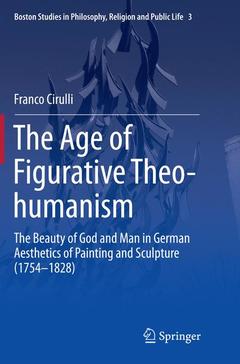Description
The Age of Figurative Theo-humanism, 2015
The Beauty of God and Man in German Aesthetics of Painting and Sculpture (1754-1828)
Boston Studies in Philosophy, Religion and Public Life Series, Vol. 3
Author: Cirulli Franco
Language: English
Approximative price 52.74 €
In Print (Delivery period: 15 days).
Add to cartPublication date: 10-2016
Support: Print on demand
Approximative price 52.74 €
In Print (Delivery period: 15 days).
Add to cartPublication date: 05-2015
191 p. · 15.5x23.5 cm · Hardback
Description
/li>Contents
/li>Biography
/li>Comment
/li>
Preface.- Introduction.- I. Winckelmann: The Responsibility of Aesthetic Response.- II. Hemsterhuis and Herder: Sculptural Theo-humanism.- III. Moritz, Wackenroder, Schelling: Tragic Theo-aesthetics.- IV. The Jena Circle and Hegel: The Modernity of Painting.- V. Conclusion.
Explores the theological and humanist concerns that animate German philosophical discourse on sculpture and painting, circa 1754-1828
Critiques the widespread assumption that German Romanticism and Idealism reduced the originally religious nature of figurative art to a formalist worship of beauty and of unbridled artistic autonomy
Provides an historical framework for contemporary debates about the nature and future of aesthetics
Includes supplementary material: sn.pub/extras




